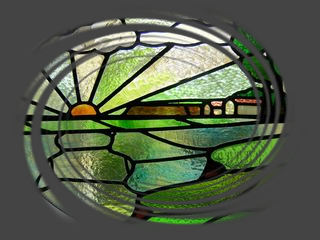 |
Coniston Copper Mines, Cumbria |
 |
Coniston Copper Mines, Cumbria |
As a caver you get to visit some spectacular places. Most of them are created by nature, but just occasionally something created by man can be as stunning
This is the case with Coniston Copper Mines, in
Coppermines Valley just north of Coniston town in Cumbria in the
Lake district. They are a series of man made near vertical rifts
where the mineral vein has been mined out on levels which can be
visited with the correct equipment.
Two main copper-rich vein systems (Bonser and
Paddy End veins) were mined at Coniston. This trip was into the
Paddy End Vein, however we did pop in the small tunnel near the
Youth Hostel which is in the Bonser Vein.
The last two pictures in the set are looking into
the flooded East Bonser Shaft
The trip starts near Lever Water high on the
hillside and descends via three main abseils and a number of
horizontal passages to the Hospital level where you can exist
with a relatively short walk back down to the cars.
The mines were most active in the 1850s and by the 1870s. Getting to the copper veins at depth could only be done by descending wooden ladders and stagings. Some of the workings were over 1100ft below the surface and around 500ft below sea level and are not a place for the faint hearted as their exploration requires you to abseil in and also to traverse along floors which may be seemingly solid, but when you abseil through the next level you can see that you were walking on a solidified layer that was once supported by timbers that have long rotted away. For this reason it is imperative in my mind that you visit these systems with a guide who knows the way through the passages and knows where is safe and is not safe, and where may have changed which would definitely indicate the latter
In one of the pictures you can see a caver clipped
to a wire line as he steps carefully along a pair of iron
scaffold tubes across a drop that is beyond the reach of a
caving lamp. This is one of the "fixed aids" that have been
placed in the mine by the members of the local mine exploration
society. No guarantees are given however and it's up to each
cave explorer to decide what level of danger they are willing to
accept for themselves. I have to admit that this place was as
close to my personal limit as I want to go for quite a while.
The country rock is volcanic so progress would have been very slow with a lot of hard work needed to extract the ore, also this is a relatively remote place and therefore there would have been signficant transport costs to get the ores to market. The main ore mineral by quantity taken from these mines was Chalcopyrite, although many other copper minerals and other minerals were taken as well.
Since the copper deposits were worked out, water has been flowing through the rocks and dissolving it in places and bringing copper based minerals to the surface of the rocks in the open tunnels
The chemical processes are similar to the processes described
in the Cave Geology pages
where there is a description of how Calcium Carbonate (calcite)
speleothems are formed. Here, as the water evaporates the Copper
is deposited in the form of copper sulphates and possibly some
carbonates which are these spectacular blue colours
If you do not fancy the underground trip, but still want to explore
the area I can recommend it as a walking location because the views are
spectacular. it's just important to remember as you look at the views
how much of that landscape is man made, with Old mining buildings making
up the current Youth Hostel and cottages and spoil tips and ore
processing areas and artifacts covering a wide area and almost every road and bridge having put in simply because of this formerly lucrative industry
The pictures are all taken with a Olympus E-500 E-series camera with a 14-42mm kit lens carried into the cave in a Pelicase which is waterproof and rugged. It has been padded with foam to absorb shocks
They are lit with a single FL-36 Flashgun directly connected to the camera via a spiral cable
The photographs were taken on a trip organized by the International Society for Spelaeological Art (ISSA) with assistance from other members of the team in holding flashguns and/or as models
For more information on cave geology and cave
formations please take a look at the Cave Geology page
For more information on these mines I suggest
taking a look at the information available on the Aditnow
website or that on the Ruskin
Museum website
For more information on caving and visiting mines please take a look at the links page